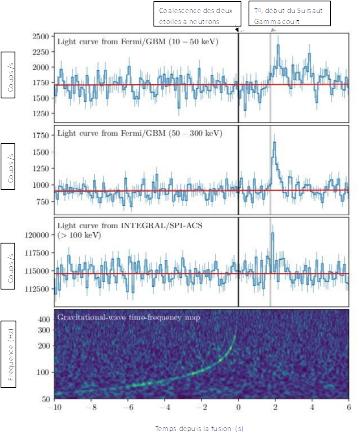Discovery of the simultaneous emission of a gravitational wave and of gamma photons by a binary system of coalescing neutron stars
For the first time, a gravitational wave (GW170817) was detected simultaneously (within 2 seconds) with a photon emission in the form of a short-lived gamma ray burst (GRB170817A). The gravitational wave was detected by LIGO (Advanced Laser Interferometer Gravitational-Wave Observatory) and Virgo, the gamma ray burst by the Gamma-ray Burst Monitor (GBM) of the FERMI satellite and by the SPI spectrometer aboard the INTEGRAL mission. These independent detections make it possible to identify this event with the coalescence (fusion) (1) of two neutron stars.

Signal received by the FERMI/GBM instrument for GRB 170817A, between 10 and 50 keV The same applies to a higher energy band (between 50 and 300 keV). Signal received by the detectors of the shield of the INTEGRAL/SPI spectrometer between approximately 100 keV and 80 MeV. Spectrogram of GW170817 obtained with data from LIGO-Hanford and LIGO-Livingston. The yellow-green curve shows the increase of the received signal at higher and higher frequencies, as the two objects approach each other, spiralling faster and faster around each other, until the final coalescence.This discovery is of major importance for fundamental physics and astrophysics.
- It made it possible to associate a gravitational wave with an “astrophysical object”.
- It confirms that short gamma-ray bursts can be produced during coalescences of neutron stars (as predicted by many models).
- This “simultaneous” detection makes it possible to measure, for the first time, the speed of propagation of the gravitational wave, giving a value very close to (or even identical to) that of light.
- It brings new constraints on the Lorentz invariance principle (2) and the equivalence principle (3). Both are crucial tests for the theory of General Relativity.
In a second step, these concordant detections triggered observation campaigns in all wavelength domains, which themselves brought many new results on the consequences of this star fusion.
The resulting object was first identified in optics, infrared, ultraviolet, then, a few days later, in X-rays and finally in radio.
These “delayed” emissions come from a “kilonova” (similar to a small supernova). They are due to the dissipation of the energy released during this extremely violent event and bear witness to the processes involved (radioactive decay of heavy elements created during or just after fusion, acceleration of particles in the form of a jet, interaction with the surrounding environment, etc.).
For the first time, physicists and astrophysicists have observations that are decisive for understanding both the stages following the coalescence of two neutron stars (which object is created? what happens to it?), the mechanisms of production of short gamma-ray bursts and the connection between these two phenomena.
We see here all the importance and power of this new observation mode brought by gravitational wave detectors. Their use coupled with the traditional observatories of Astrophysics opens an immense field of discoveries.
Let us also note the major interest of space observatories: the atmosphere of our planet is totally opaque to X and Gamma radiation. The X/Gamma photon detectors are thus embarked on board satellites. France, with the CNES and the CNRS and CEA laboratories, has been participating in these instruments for several decades.
The future of gravitational wave detectors will also be based on space-based resources: ESA’s e-LISA mission is scheduled for launch in 2034. By freeing themselves from terrestrial noise, eLISA detectors promise spectacular advances in our knowledge of the Universe.
GLOSSARY
(1) Coalescence: The meeting of two compact objects (here, two neutron stars), when they are attracted to each other under the action of their respective fields of gravity and merge (also called ‘fusion’).
(2) Lorentz’s invariance principle: Lorentz’s invariance (the conservation of certain quantities regardless of the inertial frame of reference in which they are measured) is a fundamental principle for physical laws as they are currently understood. Many tests seek to highlight violations of this invariance principle, in the framework of alternative theories that question, for example, the theory of General Relativity.
(3) Equivalence principle: Principle according to which two bodies subjected to the gravitational field alone fall at the same speed, whatever their masses or compositions. In the context of the General Relativity theory, this means that the effects of a gravitational field are identical to the effects of an acceleration of the observer’s frame of reference.
THE INSTRUMENT
INTEGRal (INTernational Gamma-Ray Astrophysics Laboratory): ESA High Energy Astrophysics Mission launched on 17 October 2002.
SPI (SPectrometer for Integral): High spectral resolution telescope operating from 20 keV to 8 MeV. Built under CNES prime contractorship with the collaboration of several European countries and the United States. SPI, some data :
- 1228 kg
- 19 high-purity Germanium detectors cooled to 80K
- energy resolution: 2.5 keV to 1 MeV – Active shielding in BGO – Integrated at CNES in Toulouse.
- In operation for 15 years; still nominal operation
PUBLICATIONS
- “INTEGRAL DETECTION OF THE FIRST PROMPT GAMMA-RAY SIGNAL COINCIDENT WITH THE GRAVITATIONAL EVENT GW170817”, Savchenko et al., acceptée a ApJL. IntegralGW.pdf 810.96 kB
- “MULTI-MESSENGER OBSERVATIONS OF A BINARY NEUTRON STAR MERGER”, Abbott et al., acceptée à ApJL. MMAGW.pdf 2.04 MB
- “GRAVITATIONAL WAVES AND GAMMA RAYS FROM A BINARY NEUTRON STAR MERGER: GW170817 AND GRB 170817A”, LVC, FERMI/GBM and INTEGRAL collaboration, acceptée à ApJL. LVC-FERMI-Integral.pdf 1.59 MB
- INTEGRAL sees blasts travelling with gravitationnal waves
- NASA Missions Catch First Light from a Gravitational-Wave Event
- Les télescopes de l’ESO détectent la toute première lumière issue d’une source d’ondes gravitationnelles
- Les ondes gravitationnelles font la première lumière sur la fusion d’étoiles à neutrons
- Actu Presse : Des étoiles à neutrons secouent la Terre – Le Monde
IRAP CONTACTS
- Jean-Pierre Roques, IRAP (CNRS/Université Paul Sabatier-Toulouse III), jean-pierre.roques@irap.omp.eu, tél 05 61 55 64 53
- Elisabeth Jourdain, IRAP (CNRS/Université Paul Sabatier-Toulouse III), elisabeth.jourdain@irap.omp.eu, tél 05 61 55 66 37






